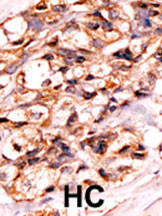

| WB | 咨询技术 | Human,Mouse,Rat |
| IF | 咨询技术 | Human,Mouse,Rat |
| IHC | 1/100-1/500 | Human,Mouse,Rat |
| ICC | 技术咨询 | Human,Mouse,Rat |
| FCM | 咨询技术 | Human,Mouse,Rat |
| Elisa | 咨询技术 | Human,Mouse,Rat |
| Aliases | Bcl2-associated agonist of cell death, BAD, Bcl-2-binding component 6, Bcl-2-like protein 8, Bcl2-L-8, Bcl-xL/Bcl-2-associated death promoter, Bcl2 antagonist of cell death, BAD, BBC6, BCL2L8 |
| Entrez GeneID | 572 |
| WB Predicted band size | 18.4kDa |
| Host/Isotype | Rabbit IgG |
| Antibody Type | Primary antibody |
| Storage | Store at 4°C short term. Aliquot and store at -20°C long term. Avoid freeze/thaw cycles. |
| Species Reactivity | Human, Mouse, Rat |
| Immunogen | This Bad Antibody is generated from rabbits immunized with a KLH conjugated synthetic phosphopeptide corresponding to amino acid residues surrounding S118 of human Bad. |
| Formulation | Purified antibody in PBS with 0.05% sodium azide. |
+ +
以下是3篇涉及Phospho-Bad(S118)抗体的参考文献,涵盖不同研究领域:
1. **"Regulation of cell death protease caspase-9 by phosphorylation"**
- **作者**: Cardone, M.H. et al.
- **摘要**: 研究AKT信号通路通过磷酸化Bad蛋白(包括Serine 118位点)抑制凋亡,促进细胞存活。文中使用Phospho-Bad(S118)抗体验证该位点磷酸化对caspase-9活性的调控作用。
2. **"The proapoptotic activity of the Bcl-2 family member Bim is regulated by interaction with the dynein motor complex"**
- **作者**: Puthalakath, H. et al.
- **摘要**: 探讨Bad蛋白磷酸化(如S118)与Bim蛋白的协同凋亡机制,通过Phospho-Bad(S118)抗体检测神经元细胞中该位点的修饰,揭示其与细胞骨架互作的关系。
3. **"Estrogen-induced activation of Erk-1 and Erk-2 requires the G protein-coupled receptor homolog, GPR30. and occurs via trans-activation of the epidermal growth factor receptor through release of HB-EGF"**
- **作者**: Filardo, E.J. et al.
- **摘要**: 研究雌激素通过GPR30激活ERK通路,导致Bad蛋白S118位点磷酸化并抑制凋亡。文中通过Phospho-Bad(S118)抗体证实该通路在乳腺癌细胞中的保护作用。
4. **"Role of Bad in the survival of cytokine-dependent myeloid cells"**
- **作者**: Scheid, M.P. et al.
- **摘要**: 分析细胞因子依赖的髓系细胞存活机制,发现IL-3通过PI3K/AKT通路诱导Bad(S118)磷酸化,使用特异性抗体证明该修饰阻断Bad与Bcl-XL的结合,从而抑制凋亡。
这些文献展示了Phospho-Bad(S118)抗体在凋亡信号通路、癌症及神经生物学等研究中的关键应用。
Phospho-Bad(S118) antibody is a specialized tool used to detect the phosphorylation of the Bad protein at serine residue 118 (S118). Bad, a pro-apoptotic member of the Bcl-2 family, regulates programmed cell death by interacting with anti-apoptotic proteins like Bcl-xL to promote mitochondrial outer membrane permeabilization and caspase activation. Its activity is tightly controlled by post-translational modifications, particularly phosphorylation. Phosphorylation at S118. mediated by kinases such as AKT or PKA in response to survival signals (e.g., growth factors), inactivates Bad by triggering its dissociation from Bcl-xL and promoting its sequestration in the cytosol via binding to 14-3-3 proteins. This mechanism suppresses Bad’s pro-apoptotic function, enhancing cell survival.
The Phospho-Bad(S118) antibody is widely used in research to study pathways involved in apoptosis resistance, cancer progression, and cellular stress responses. It enables the detection of phosphorylated Bad in techniques like Western blotting, immunohistochemistry, and flow cytometry, providing insights into the activation status of survival signaling cascades (e.g., PI3K/AKT, MAPK). Dysregulation of Bad phosphorylation is implicated in diseases such as cancer, where hyperactivation of survival pathways often correlates with therapeutic resistance. Researchers use this antibody to explore mechanisms underlying cell fate decisions, evaluate drug efficacy, or identify biomarkers associated with pathological conditions. Specificity validation via knockout controls or phosphatase treatment is recommended to ensure accurate interpretation.
×